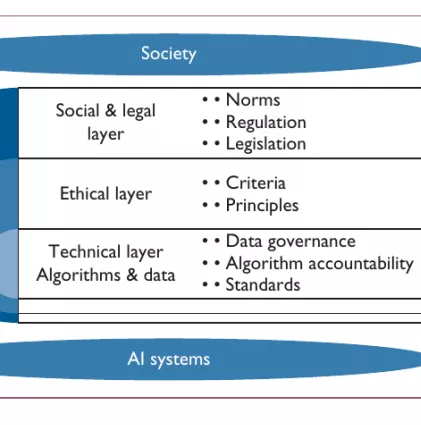
A Layered Model for AI Governance
Abstract
AI-based systems are “black boxes,” resulting in massive information asymmetries between the developers of such systems and consumers and policymakers. In order to bridge this information gap, this article proposes a conceptual framework for thinking about governance for AI.
Many sectors of society rapidly adopt digital technologies and big data, resulting in the quiet and often seamless integration of AI, autonomous systems, and algorithmic decision-making into billions of human lives. AI and algorithmic systems already guide a vast array of decisions in both private and public sectors. For example, private global platforms, such as Google and Facebook, use AI based filtering algorithms to control access to information. AI algorithms that control self-driving cars must decide on how to weigh the safety of passengers and pedestrians. Various applications, including security and safety decision making systems, rely heavily on A-based face recognition algorithms. And a recent study from Stanford University describes an AI algorithm that can deduce the sexuality of people on a dating site with up to 91 percent accuracy. Voicing alarm at the capabilities of AI evidenced within this study, and as AI technologies move toward broader adoption, some voices in society have expressed concern about the unintended consequences and potential downsides of widespread use of these technologies.
To ensure transparency, accountability, and explainability for the AI ecosystem, our governments, civil society, the private sector, and academia must be at the table to discuss governance mechanisms that minimize the risks and possible downsides of AI and autonomous systems while harnessing the full potential of this technology. Yet the process of designing a governance ecosystem for AI, autonomous systems, and algorithms is complex for several reasons. As researchers at the University of Oxford point out ,3 separate regulation solutions for decision-making algorithms, AI, and robotics could misinterpret legal and ethical challenges as unrelated, which is no longer accurate in today’s systems. Algorithms, hardware, software, and data are always part of AI and autonomous systems. To regulate ahead of time is difficult for any kind of industry. Although AI technologies are evolving rapidly, they are still in the development stages. A global AI governance system must be flexible enough to accommodate cultural differences and bridge gaps across different national legal systems. While there are many approaches we can take to design a governance structure for AI, one option is to take inspiration from the development and evolution of governance structures that act on the Internet environment. Thus, here we discuss dierent issues associated with governance of AI systems, and introduce a conceptual framework for thinking about governance for AI, autonomous systems, and algorithmic decision-making processes.

